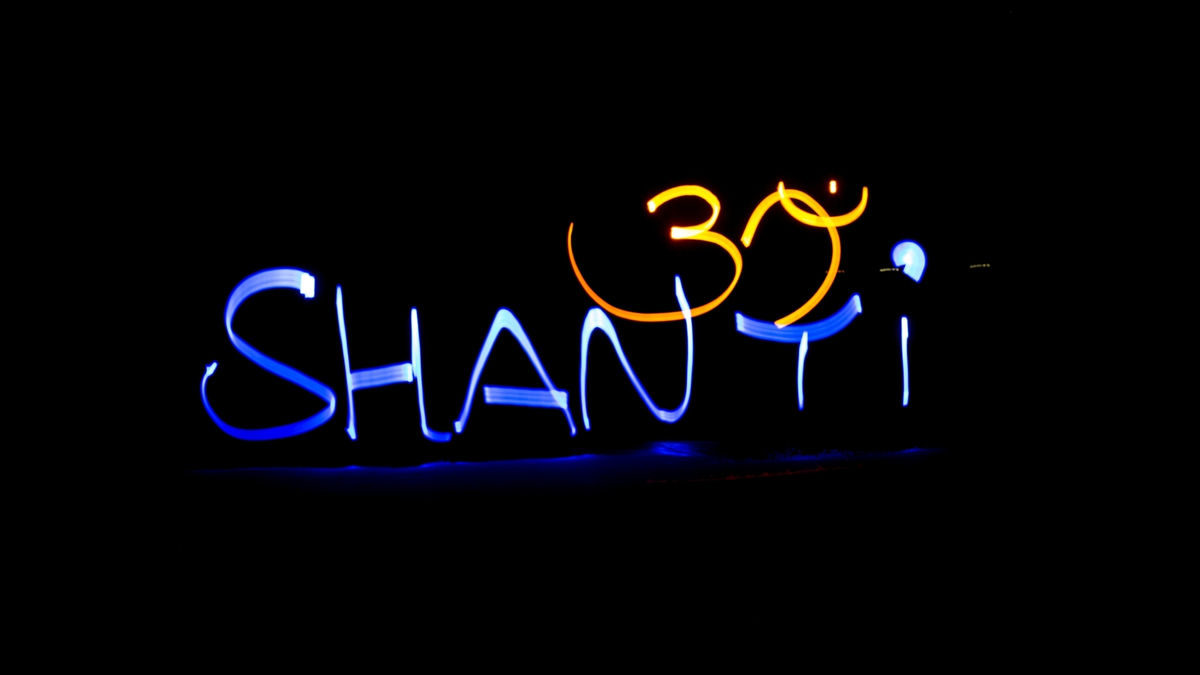Table of contents
General Meaning of Om Shanti

In the practice of meditation, it is common to use mantras - which are sounds, syllables or words, said aloud to concentrate the mind and favor the connection of the meditator with his inner self with other individuals and with the universe, as well as to achieve certain specific results.
One such mantra is Om Shanti, which has its origins in Hinduism and has been adopted by Buddhist and Jain traditions. It is attributed the power to bring serenity to those who chant it and to promote peace in the universe.
In this article, we will deal with the origins and use of Om Shanti, including in yoga, and the role mantras play in achieving our goals, especially in attaining inner peace, incorruptible and imperturbable, and the quest for spiritual enlightenment. Check it out!
Om Shanti, meaning, power and intonation

Om Shanti, linked to inner peace and widely used in yoga practice, is one of the best known mantras. We will examine its meaning, its origins, the powers it possesses and how it should be chanted to produce its beneficial effects in our lives. Follow along!
The Om Shanti Mantra
The Om Shanti mantra originated in Sanskrit, one of the many languages that have coexisted on the Indian subcontinent since time immemorial.
One of the particularities of this language is that, with the passing of time, it ceased to be used in the performance of everyday activities: its use was restricted to the celebration of spiritual ceremonies and to the transmission of philosophical and spiritual knowledge that was codified in works written in it by the sages of antiquity.
The Upanishads, important Hindu scriptures, are examples of works that were written in Sanskrit.
Meaning of Om in Sanskrit
According to Mandukya Upanishad, one of the Upanishads, the syllable OM is all there is and encompasses in itself the past, the present and the future. Considered the primordial sound of the universe, it symbolizes the cyclical alternation between death and rebirth, destruction and creation.
Because of the senses this sound evokes, we could loosely translate Om as "reality" or "universe," as it represents all aspects of our reality, good or bad, peaceful or tormenting, joyful or sad.
Meaning of Shanti in Sanskrit
Shanti, in Sanskrit, refers to inner peace, a state of serenity and balance in which intellect and emotions are in harmony and which resists even adversity because its foundations are in the soul, not in the body.
One of the aims of meditation is to grow spiritually to the point where one can let go of material concerns and attain the undisturbed peace that Shanti represents.
The power of Om Shanti
According to the meanings of Om and Shanti presented above, we could translate Om Shanti as "universal peace" understand the mantra as an expression of the incorporation of peace into our reality.
According to the practices that make use of it, the Om Shanti mantra favors the connection with the divine and serves as a form of protection against adversities on the material plane while strengthening the meditator internally to face them without disturbing his tranquility.
Using Om Shanti in daily practice
Incorporating the Om Shanti mantra into daily meditation practice makes it easier to achieve the ends of meditation, including spiritual development. The use of mantras promotes concentration of the meditator's attention and energy, making it easier for the meditator to reach higher levels of consciousness. The use of Om Shanti, specifically, promotes serenity in the face of problems and negative circumstancesthat are so common in the universe.
To chant a mantra, it is best to find a quiet environment in which there is little chance of interruptions and interference. Sit on the floor, close your eyes and keep your legs crossed.
As for your hands, you can either put them together and raise them to chest height or let them be palms up, each resting on one knee with thumb and forefinger together. In the indicated position, start the meditation and try to connect to the divine and to your inner self. After you have done the above, repeat in the same tone the mantra Om Shanti at least three times.
The best way to chant Om Shanti
The "o" of Om is open and should be prolonged. The word "om" should resonate through the person's body as he chants it. The "a" of shanti should be prolonged a little and is pronounced like the letter "a" in the English word "father", but if you cannot pronounce it that way, the "a" of "fa" is a suitable substitute.
Don't worry about the exact pronunciation of these sounds, as intonation and concentration are far more important than it.
Om Shanti, Shanti, Shanti, the triple peace wish
One of the most common ways to use the Om Shanti mantra in meditation is by chanting the sound Om and following it with the word Shanti three times: Om Shanti Shanti Shanti. This form of the Om Shanti mantra represents the desire for peace threefold: expressed in the mind, expressed in the word and expressed in the body.
The use of the Om Shanti Shanti Shanti form is also used, especially in Yoga practice, to deal with the sources of disturbances that, like clouds of mosquitoes, surround us wherever we are, confuse, exasperate and distract us, blocking or diverting our search for enlightenment.
Ideally, the expression of triple peace can give us serenity so that the mind does not become clouded, lucidity so that we distinguish reality from illusions, and wisdom so that we separate what is relevant from what is not.
The three universal conflicts and Om Shanti in Yoga

One of the reasons for using the mantra Om Shanti Shanti Shanti in Yoga is to deal with the three universal conflicts, also called the three conflicts that prevail in the universe, with which we will become more familiar later on. Check out more on this subject in the following topics!
The power of the mantra OM in Yoga
Chanting the mantra OM has a very calming effect on the mind of those who do it. Doing it before practicing Yoga helps to establish the connection with oneself that is sought in this activity, intensifying and prolonging the beneficial effects achieved in it.
Meaning of Om Shanti in Yoga
Often, Om Shanti is used in Yoga as a greeting by which one expresses the wish for the interlocutor to enjoy peace.
In Yoga practice, the Om Shanti mantra may also be chanted. In this case, it is common to use the Om Shanti Shanti Shanti form for the purpose of dealing with the three types of conflicts that prevail in the universe, each of which is prevented or neutralized by the chanting of one shanti.
The three conflicts that prevail in the universe
The three conflicts prevailing in the universe are called Adhi-Daivikam, Adhi-Bhautikam, and Adhyatmikam. These terms designate three categories of sources of disturbances to peace, which must be overcome for spiritual enlightenment to occur.
Achieving enlightenment is a goal favored by incorporating the Om Shanti mantra into meditation practice.
Adhi-Daivikam
Adhi-daivikam is the conflict over which we cannot have control. It refers to disturbing phenomena that seem to be decided on a divine plan, higher than ours, and evade our efforts to foresee or avert them. Examples of these are accidents, illnesses, storms, etc.
The word shanti is chanted the first time for the purpose of evoking liberation from the disturbances caused by such phenomena.
Adhi-Bhautikam
Adhi-bhautikam is the conflict caused by objects and individuals outside us, that is, by elements in the material world that surrounds us and over which we have some measure of control: arguments, annoying sounds, etc. The word shanti is chanted the second time in order to evoke liberation from the disturbances caused by the world around us.
Adhyatmikam
Adhyatmikam is the conflict arising within ourselves, from our attachment or ego, which give rise to fear, envy, hatred and other negative feelings. The third time, the word shanti is chanted to evoke the release of the disturbances caused by attachment and ego and their replacement with detachment, humility, compassion, peace and love.
Mantras, what they are for and benefits

As we have seen, mantras can be used as an aid in the practice of meditation. Now, we will discuss in more detail their nature and the benefits they bring. Check it out!
What is a mantra
Mantras are sounds (syllables, words, sets of words, etc.) to which spiritual powers are attributed. The activity of chanting them helps the meditator to concentrate and generates specific energetic vibrations that help raise his consciousness to higher levels. Each chant also has its specific effects.
According to the Vedas, a body of Hindu scriptures of which the Upanishads are a part, mantras were not created or discovered by human ingenuity, but assimilated from a higher plane by advanced meditation practitioners.
Meaning of Mantras
The word mantra comes from Sanskrit and is composed of the root "man", which has the meaning of mind, and the ending "tra", which has the meanings of "instrument" and "wisdom".
According to the etymology presented above, mantras can therefore be understood as instruments for preserving the mind in the face of negative factors and for the pursuit of wisdom and enlightenment.
In general, mantras come from Sanskrit, whose sounds produce energetic vibrations related to what they are called. Although mantras may have translatable meanings into modern languages such as Portuguese, the subtlety of their energetic nature hinders translation efforts.
Due to the difficulties of translating from Sanskrit, it is not uncommon that in the same language there are several interpretations of the same word from that language, sometimes giving rise to doubts and misunderstandings.
Moreover, the most fundamental and profound meaning of these words transcends the meaning they receive in modern languages. The connection to this most fundamental meaning needs to be made through the soul of the wisdom seeker.
What they are used for
Mantras, as we have said, produce energetic vibrations. They influence the energy and mind of the person who chants them, which allows the meditator to connect to his or her inner self and ascend to higher states of consciousness. They also have a calming effect on the nervous system and help to concentrate the mind.
Benefits
Based on the effects of mantras mentioned above, we can list some of the benefits of their incorporation into daily practice as the promotion of tranquility, strengthening emotional balance, sharpening attention and increasing the efficiency with which the brain processes the information it receives.
The frequent use, ideally daily, of mantras is also linked to the chakras, energy foci in our bodies on which they produce a beneficial effect that rebalances the body's energy. The mantra OM is one of those that have an intense positive effect on the chakras.
Om Namah Shivaya, Om Gam Ganapataye Namaha and mantras to sleep

In addition to the general positive effects of the practice of chanting mantra, the use of specific mantras has specific effects. Below, we will explain the effects of Om Namah Shivaya and Om Gam Ganapataye Namaha mantras and how mantras can help you sleep better.Check it out!
Om Namah Shivaya, the powerful mantra
According to the knowledge bequeathed by the Vedas, Om Namah Shivaya is one of the mantras with the most intense effects. It can be translated as "I invoke, honor and bow to Shiva" and reveres, in the form of the mentioned Hindu divinity, what is divine in each human being, including in who intones the mantra.
Om Namah Shivaya mantra is associated with revitalization of the ability to renew oneself and the creation of energetic vibrations that promote harmony and peace.
The practice of chanting Om Namah Shivaya repeatedly produces several benefits, among which are balancing the emotions, calming the mind and enabling access to higher states of consciousness through meditation.
Om Gam Ganapataye Namaha, for attraction of prosperity
Om Gam Ganapataye Namaha is a mantra related to Ganesha, a deity whom the Vedas link to wisdom and to whom they attribute the power to remove spiritual or material obstacles in an individual's path.
This mantra intensifies the energy of those who chant it, strengthens the ability to concentrate, helps to seek new paths to desired goals and facilitates achieving prosperity.
Mantras for better sleep
In general, the use of mantras facilitates the establishment of a connection between the one who meditates and his own divine nature, promotes the pacification of the mind, which is freed from worries, and produces relaxation of the body. For this reason, they can be very useful for those who wish to sleep better.
Among the mantras that can induce a state of relaxation conducive to a quality and invigorating sleep is the already mentioned OM, which creates vibrations of peace and tranquility and brings harmony to the environment, creating appropriate circumstances for good sleep.
Besides the use of mantras and practices such as Yoga to relax, it is recommended that the person who wants a better sleep should use, if possible, relaxing resources such as a bath or a massage, avoid the use of electronic devices just before going to sleep and reduce as much as possible the light in the place where they will sleep.
How does chanting the Om Shanti mantra benefit my life?

The habit of chanting mantras has positive effects on the body and mind because they give rise to energetic vibrations that have a salutary influence on one's mood, energy and body.
As we have seen, specific mantras produce specific results, and Om Shanti is no exception to this rule. When it is chanted, Om Shanti helps to achieve serenity in the face of life's vicissitudes and to achieve the spiritual progress produced by the connection with the inner self.
It is also considered a form of protection against the disturbances produced by the three forms of conflict prevalent in the universe, which are on the path to spiritual enlightenment.
The balance promoted by periodically chanting the Om Shanti mantra has beneficial effects on body and mind, helping the mind to free itself of worries and negative feelings and helping the body to relax and revitalize itself, promoting health and well-being.

